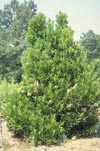Home > Tree selection > Uncommon trees zone 8-9 > Viburnum awabuki
Viburnum awabuki, Sweet Viburnum
Plant often grows in late fall and is injured by cold in the northern portion of its range. You might see the plant listed elsewhere as hardy in zone 8 or even zone 7, but foliage is usually burned back by the cold as the plant has trouble going dormant. Plants in zone 8 often begin growing in a warm winter period and can be burned by the next freezing temperatures. Foliage in full sun burns in extended summer dry periods in the eastern US but with little if any twig die-back. You might find this plant listed as V. awabuki, V. japonica, V. macrophyllum or V. odoratissimum var. awabuki. There appears to be considerable confusion as to what to call this plant.
Large, leathery, medium to light green, non-fragrant when crushed, highly lustrous leaves and clusters of extremely fragrant, small, white flowers, completely covering the plant in springtime, make Awabuki Sweet Viburnum a plant with great appeal. The shiny leaves are quite distinctive from the dull, dark green, blunt-tip, non-fragrance leaves of V. odoratissimum. Foliage drops in drought. The flowers are often followed by small, showy red berries which are highly ornamental and turn black when ripe. Fruit set in my yard is minimal to fair probably because there is not a cross pollinator nearby. This plant is considered mostly allergy free and causes little or no allergy problems in most people.
It is often used as a screen or clipped hedge. Its dense, spreading, evergreen habit makes Sweet Viburnum suitable for use as a small tree, reaching only about 15 to 20 feet at maturity, with an dense, multi-branched, rounded canopy. Branches often droop to the ground. This is a small tree which should be tried, and some nursery operators are beginning to grow it. It is not uncommon in central and south Florida.






